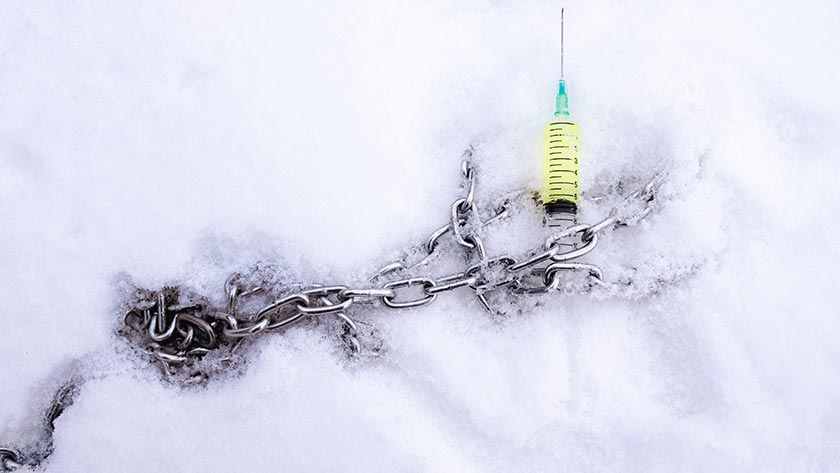In November 2020, pharmaceutical companies Pfizer and BioNTech announced promising early results for their vaccine against SARS-CoV-2 (COVID-19). This mRNA vaccine was found to have 90 per cent efficacy in phase 3 human trials on nearly 44,000 volunteers.1 This means that for every 10 people administered the vaccine, one went on to develop COVID-19, a far better result than earlier expectations of a COVID-19 vaccine where 50 per cent efficacy was being considered acceptable.1
Interim results
However, there remain a number of important issues to be addressed before this Pfizer vaccine, and a similar one in development by Moderna Inc, can enter clinical use. The results announced in November were interim – the study itself will not be completed until a set number of participants have developed COVID-19 after being administered the vaccine and until all participants have been followed for at least two months to detect any adverse effects of the vaccine itself and to discover the duration of protection.1 Due to the urgent nature of the pandemic, this follow-up time is much shorter than usual.2 It was also noted in earlier phase 1 and 2 trials that the vaccine was less effective in older adults (65 to 85 years) although phase 3 trials are showing equal effectiveness in this age group.3
RNA vaccine technology is untried in humans prior to COVID-19. Older vaccine technologies inject either inactivated or reconstructed particles from the infectious pathogen. In this new method, the body is injected with a sequence of messenger RNA that encodes for a viral protein. The strand of mRNA enters cells and triggers the manufacture of the viral protein, which is then released into the tissues, or inserted onto the surface of the cell.2
This then triggers the body’s immune system to manufacture antibodies against the “foreign” protein, generating an immune memory that quickly reactivates should the person encounter the actual virus in the future – much in the same way as traditional vaccines. The body breaks down the mRNA within hours of the injection, necessitating a minimum of two injections.2
A key advantage of mRNA vaccine technology is the ability to rapidly produce the correct RNA sequence for a pathogen – allowing laboratories to produce a variety of vaccines in quick order. This may be an important mechanism if the SARS-CoV-2 virus is able to mutate rapidly – especially its spike protein, which is a key element of the infectious strategy of the virus. Also, these vaccines do not need to be “grown up” in eggs or other cells so, in theory, are easy to produce rapidly and at scale.2
The major challenge for mRNA vaccines is the cold chain requirements. They must be stored between -20οC (Moderna) and -70οC (Pfizer) making distribution in developing nations, especially those with tropical climates, almost impossible. Less than 10 per cent of countries meet the World Health Organization recommendations for effective vaccine management practices currently,4 where cold chain requirements for most vaccines vary between +2οC and +8οC.5
These extreme cold chain requirements, combined with lack of manufacturing and distribution resources and health-care personnel, and a degree of vaccine scepticism/hesitancy in the population may delay effective world-wide protection against COVID-19.
Another issue is that most vaccines prevent disease, but not infection. By suppressing COVID-19 disease but not limiting SRAS-CoV-2 infection rates, those for whom the vaccine is less effective (eg older adults) or those who are unable or refuse to be vaccinated could be more at risk when transmission mitigating behaviours become less common among the vaccinated.6
References
- Al-Wassiti, H., Pouton, C., & Quinn, K. (2020). 90% efficacy for Pfizer’s COVID-19 mRNA vaccine is striking. But we need to wait for the full data. The Conversation.
- Abbasi, J. (2020). COVID-19 and mRNA vaccines – first large test for new approach. JAMA, Journal of the American Medical Association, 324(12), 1125-1127.
- Krammer, F. (2020). SARS-CoV-2 vaccines in development. Nature, 586, 516–527. https://doi.org/10.1038/s41586-020-2798-3
- Shin, M., Shukla, S., Chung, Y., Beiss, V., Chan, S., Ortega, O., Wirth, D., Sack, M., Pokorski, J., & Steinmetz, N. (2020). COVID-19 vaccine development and a potential nanomaterial path forward. Nature Nanotechnology, 15(8), 646–655.
- Ministry of Health. (2019). National Standards for Vaccine Storage and Transportation for Immunisation Providers (2nd ed). Wellington: Author.
- Bar-Zeev, N., & Ingelsby, T. (2020). COVID-19 vaccines: early successes and remaining challenges. The Lancet, 396, 868-869.




